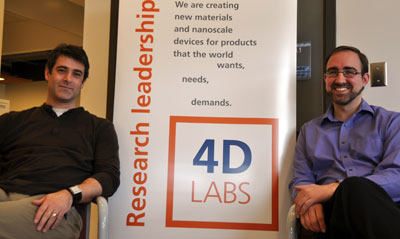Home > Press > Nanoscale research nets macro funding
 |
Abstract:
SFU's 4D LABS materials science research centre is getting about $884,000 from Western Economic Diversification Canada to add new scientific equipment for faster prototyping.
The Burnaby campus facility houses materials fabrication and design operations that help scientists research and create new technologies. The equipment will help accelerate product commercialization and spin-off companies in key sectors such as nanotechnology, energy and life sciences.
Nanoscale research nets macro funding
Burnaby, BC Canada | Posted on July 9th, 20094D LABS executive director Neil Branda and nanofabrication director Byron Gates—both Canada Research Chairs and renowned material scientists—will use the funds to build a Canadian state-of-the-art mask-writing facility in the centre's already impressive nanofabrication laboratory.
Masks are the stencils used in nanolithography to determine which areas are exposed for etching during the fabrication of devices such as semiconductor integrated circuits and nanoelectromechanical systems.
"This new facility will transform academic and private industry researchers' ability to quickly and cost-effectively develop and design new micro- and nanofabricated materials and devices," says Branda, a 4D LABS cofounder.
Using lithographic and mask-making processes, scientists can pattern materials with nano features to create foundations for new technology platforms. For example, nanofeatures could form the critical components in electronic and biomedical diagnostic devices.
Currently, the closest source of masks with micron-scale features (500 nanometres to 100-plus micrometres—about the diameter of a human hair) is Alberta. The SFU mask-writing facility will be able to produce nano- and micron-scale features and structures less than 20 nanometres (about 10,000 times smaller than a human hair).
Researchers will also be able to rapidly write features directly onto materials and structures, eliminating the need for extensive lithographic patterning and allowing for the creation of 3D nanoscale features.
"This capability will eventually be as key to nanoscale materials fabrication as the photocopier is to information dissemination," explains Gates. "We'll be able to fabricate the next generation of technologies, particularly in the fields of alternative energy and biomedical engineering."
####
For more information, please click here
Contacts:
Public Affairs and Media Relations
Simon Fraser University
Strand Hall
8888 University Drive
Burnaby BC V5A 1S6
Canada
Tel: 778.782.3210
Fax: 778.782.3039
Email:
Copyright © Simon Fraser University
If you have a comment, please Contact us.Issuers of news releases, not 7th Wave, Inc. or Nanotechnology Now, are solely responsible for the accuracy of the content.
| Related News Press |
News and information
![]() Researchers develop molecular qubits that communicate at telecom frequencies October 3rd, 2025
Researchers develop molecular qubits that communicate at telecom frequencies October 3rd, 2025
![]() Next-generation quantum communication October 3rd, 2025
Next-generation quantum communication October 3rd, 2025
![]() "Nanoreactor" cage uses visible light for catalytic and ultra-selective cross-cycloadditions October 3rd, 2025
"Nanoreactor" cage uses visible light for catalytic and ultra-selective cross-cycloadditions October 3rd, 2025
Govt.-Legislation/Regulation/Funding/Policy
![]() New imaging approach transforms study of bacterial biofilms August 8th, 2025
New imaging approach transforms study of bacterial biofilms August 8th, 2025
![]() Electrifying results shed light on graphene foam as a potential material for lab grown cartilage June 6th, 2025
Electrifying results shed light on graphene foam as a potential material for lab grown cartilage June 6th, 2025
![]() Institute for Nanoscience hosts annual proposal planning meeting May 16th, 2025
Institute for Nanoscience hosts annual proposal planning meeting May 16th, 2025
Announcements
![]() Rice membrane extracts lithium from brines with greater speed, less waste October 3rd, 2025
Rice membrane extracts lithium from brines with greater speed, less waste October 3rd, 2025
![]() Researchers develop molecular qubits that communicate at telecom frequencies October 3rd, 2025
Researchers develop molecular qubits that communicate at telecom frequencies October 3rd, 2025
![]() Next-generation quantum communication October 3rd, 2025
Next-generation quantum communication October 3rd, 2025
![]() "Nanoreactor" cage uses visible light for catalytic and ultra-selective cross-cycloadditions October 3rd, 2025
"Nanoreactor" cage uses visible light for catalytic and ultra-selective cross-cycloadditions October 3rd, 2025
Tools
![]() Japan launches fully domestically produced quantum computer: Expo visitors to experience quantum computing firsthand August 8th, 2025
Japan launches fully domestically produced quantum computer: Expo visitors to experience quantum computing firsthand August 8th, 2025
![]() Rice researchers harness gravity to create low-cost device for rapid cell analysis February 28th, 2025
Rice researchers harness gravity to create low-cost device for rapid cell analysis February 28th, 2025
Printing/Lithography/Inkjet/Inks/Bio-printing/Dyes
![]() Presenting: Ultrasound-based printing of 3D materials—potentially inside the body December 8th, 2023
Presenting: Ultrasound-based printing of 3D materials—potentially inside the body December 8th, 2023
![]() Simple ballpoint pen can write custom LEDs August 11th, 2023
Simple ballpoint pen can write custom LEDs August 11th, 2023
![]() Disposable electronics on a simple sheet of paper October 7th, 2022
Disposable electronics on a simple sheet of paper October 7th, 2022
|
|
||
|
|
||
| The latest news from around the world, FREE | ||
|
|
||
|
|
||
| Premium Products | ||
|
|
||
|
Only the news you want to read!
Learn More |
||
|
|
||
|
Full-service, expert consulting
Learn More |
||
|
|
||








